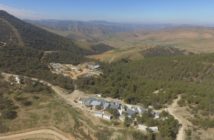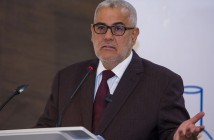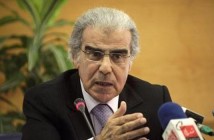By ADAM GOLDMAN, EILEEN SULLIVAN and MATT APUZZO – Associated Press | AP – 3 hrs ago


NEW YORK (AP) — The New York Police Department put American citizens under surveillance and scrutinized where they ate, prayed and worked, not because of charges of wrongdoing but because of their ethnicity, according to interviews and documents obtained by The Associated Press.
The documents describe in extraordinary detail a secret program intended to catalog life inside Muslim neighborhoods as people immigrated, got jobs, became citizens and started businesses. The documents undercut the NYPD’s claim that its officers only follow leads when investigating terrorism.
It started with one group, Moroccans, but the documents show police intended to build intelligence files on other ethnicities.
Undercover officers snapped photographs of restaurants frequented by Moroccans, including one that was noted for serving “religious Muslims.” Police documented where Moroccans bought groceries, which hotels they visited and where they prayed. While visiting an apartment used by new Moroccan immigrants, an officer noted in his reports that he saw two Qurans and a calendar from a nearby mosque.
It was called the Moroccan Initiative.
The information was recorded in NYPD computers, officials said, so that if police ever received a specific tip about a Moroccan terrorist, officers looking for him would have details about the entire community at their fingertips.
The documents show how New York’s rich heritage as a place where immigrants traditionally have blended in and built their lives now clashes with today’s New York, where police see blending in as one of the first priorities for would-be terrorists.
To prevent attacks, police monitored the path that generations of immigrants followed: getting an apartment, learning English, finding work, assimilating into the culture. Activities such as haircuts and gym workouts were transformed from mundane daily routines into police data points.
A U.S. citizen in Queens, for example, starts work each day at what police labeled “a known Moroccan barbershop.”
The AP previously revealed the secret operations of the NYPD intelligence division as it mapped the Muslim community in and around New York, monitored life in ethnic neighborhoods and scrutinized mosques. The Moroccan Initiative was one of the division’s projects.
Such programs began with help from the CIA under President George W. Bush and have continued with at least the tacit support of President Barack Obama, whose administration repeatedly has sidestepped questions about them. It is unclear whether New York Mayor Michael Bloomberg oversaw the programs. He has refused to comment directly about them.
In response to the AP’s earlier stories, the CIA’s inspector general is investigating whether its unusually close relationship with the NYPD was unlawful.
NYPD spokesman Paul Browne did not return messages seeking comment about the Moroccan Initiative. In an earlier email, he said the department was not involved in wholesale spying, but rather was trying to document the likely whereabouts of terrorists.
“The unit’s personnel would try to establish, for example, what border crossing a terrorist entering New York would use, what flop house he’d use, what Internet cafe he’d frequent to communicate, etc.,” he wrote.
It’s unclear exactly when the initiative began and whether it continues in any form. Current and former officials told the AP that it started in response to the 2003 suicide bombings that killed 45 people in the Moroccan city of Casablanca and the 2005 train bombing in Madrid that was linked to Moroccan terrorists.
In early meetings, police were told there was no specific threat to New York from Moroccans, officials said, but they were instructed to gather intelligence on the Moroccan community because of concerns Moroccan terrorists might strike here too.
NYPD intelligence chief David Cohen, a former senior CIA officer, oversaw the program, current and former officials said. Many of the documents obtained by the AP were prepared for Police Commissioner Ray Kelly but because of the volume of such documents his office receives, it’s unclear whether he read them.
New York City law prohibits police from using race, religion or ethnicity as “the determinative factor” for any law enforcement action. Civil liberties advocates have said that is so ambiguous it makes the law unenforceable. The NYPD has said intelligence officers do not use racial profiling or troll ethnic neighborhoods for information.
The documents obtained by the AP, many of which were marked “secret,” include a list of “Moroccan Locations,” a virtual tour of the city’s Moroccan neighborhoods. Photos of local businesses were accompanied by notes from plainclothes officers, known as rakers, who quietly kept tabs on ethnic neighborhoods and eavesdropped on conversations.
“A lot of these locations were innocent,” said an official involved in the effort, who like many others interviewed by the AP spoke only on condition of anonymity to discuss sensitive police operations. “They just happened to be in the community.”
Sometimes the notes recorded in police files were detailed, such as the officer who reported that a local sandwich shop was close to a mosque and said the store was closed during Friday prayers.
“The restaurant serves only Halal meat,” the document said. “The majority of the customers are religious Muslims.”
Halal meat is prepared under religious rules similar to kosher food.
Other businesses were described with fewer details. But in every case, the officers noted the ethnicity of the owners.
“In America, you don’t put people under suspicion without good reason,” said Rush Holt, a Democratic congressman from New Yersey, who reviewed some of the documents obtained by the AP and has urged the Justice Department to investigate. “The idea that people in a group are suspect because of being members of a group is profiling, plain and simple.”
Business owners in the Astoria neighborhood of Queens, where many of the pictures were taken, at first expressed amusement at seeing themselves alongside their friends and neighbors in documents compiled by officers hunting for terrorists.
“Police come here for what? We cut hair all day,” said Amine Darhbach, a U.S. citizen barber who charges $12 for a haircut and sends a portion of his earnings to his family in Morocco each month.
As they flipped through the documents, they said they grudgingly accepted the police attention. It is hardly news to them that, since the 2001 terrorist attacks, Muslims are under greater scrutiny by the public and law enforcement.
“We’ve been harassed for so long, it doesn’t make any sense to complain,” said Leo Santini, a cafe owner and U.S. citizen who changed his name from Mohamed Hussein because he thought he would be treated better without such an Arab name. His three American kids, he said, “don’t look Arab, so they won’t have any problems.”
Finally, there was frustration and anger about being included in police documents.
“All I want is the best for my daughter and my community and to be treated like a new American citizen,” said Sanaa Bergha, whose travel agency was among the businesses photographed in the intelligence files.
Like others, Bergha said that, if asked, she would talk to police about how she could help keep the city safe. But she’s only spoken to the police twice, she said. Once was after she was burglarized. The second was when she reported customers she suspected of making fraudulent documents.
The documents on the Moroccan businesses were compiled by a secretive team called the Demographics Unit, which police originally denied existed. After the AP obtained police documents describing the unit as a team of 16 officers with a mission to map and monitor ethnic neighborhoods, the department said the Demographics Unit used to exist but actually never had more than eight officers.
Browne, the department’s spokesman, has said the unit only followed leads. There is no indication in the documents, however, that police were only investigating criminal leads. Information about crimes was included in the Moroccan Initiative files, but these do not appear to be the program’s focus.
“The Demographics Team was instructed by me to re-canvas the city for any new locations and they came across a newly identified hotel that is referred to Moroccan tourists,” an unidentified supervisor wrote in an undated update on the initiative.
One police document, for example, lists taxi companies and Dunkin Donuts and Subway franchises known to hire Moroccans and other Arabs. A local gym and barber shop also are mentioned. The end of the document includes a section about criminal activity and identifies four businesses believed to be involved in marriage and document fraud and drug dealing.
Another document describes 14 restaurants, two travel agencies and a meat market catering to the Moroccan community. Another said the NYPD produced a list of every Moroccan cab driver in the city. Officers tried to interview them, but many were unavailable to be questioned because they were out working 12- to 14-hour shifts, the document said.
Current and former officials said the information collected by the Demographics Unit was kept on a computer inside the squad’s offices at the Brooklyn Army Terminal. It was not connected to the department’s central intelligence database, they said.
When a Moroccan was arrested, according to the documents, a unit called the Citywide Debriefing Team would visit him in jail or at his home. Each was asked how someone coming to the United States from Morocco might keep a low profile. Officers had a list of 13 questions, including where such a person might live, obtain identification cards, eat, worship and learn English.
The questions helped police identify small apartments in Brooklyn where Moroccan immigrants shared rooms soon after arriving in New York. Police visited one apartment in 2007 to meet with someone who had been arrested the prior year, according to the files. The officer noted the number of bedrooms, the layout, the furnishings and a wall calendar from a nearby mosque.
“There was a small table as well as an entertainment center,” the document said. “There were two Qurans. One on top of each speaker.”
Police officials said such detailed note-taking was the result of enormous pressure inside the department. Officers assigned to conduct interviews and visit homes were told by supervisors that, if the subject of their interviews one day turned violent, their reports would be scrutinized with an eye for what warning signs were missed, officials said.
It was intended to keep officers sharp and remind them of the seriousness of the job, but officials said it encouraged well-meaning officers to record even innocent details.
Unlike the information from the Demographics Unit, the information from debriefings and personal visits was reported back to headquarters and entered into the police department’s central intelligence database, the Intelligence Data System, officials said.
Because of lawsuits by civil liberties groups, police lawyers have set stricter limits in recent years about information the NYPD compiles about people not accused of any crime, current and former officials said. Lawyers review police reports and sometimes require officers to remove information or rewrite their reports. Some information on innocent behavior is removed. Other information is labeled “sealed,” which means it can be seen only by very senior officials, the officials said.
Meanwhile, police received from the U.S. government regular updates on foreign visitors entering New York, according to documents and interviews. Police departments often receive information on visitors on a case-by-case basis. U.S. Customs and Border Protection, which maintains the federal documents, declined to tell the AP whether such broad access to its immigration files by a city police department was unusual.
Using the documents, known as I-94s, New York police located and interviewed Moroccans and, when possible, the families they were visiting. Often, that would take them to the homes of U.S. citizens.
Police couldn’t force people to talk to them or let them inside their homes, so officers often used a cover story about a crime in the neighborhood or a report of a missing child nearby, officials told the AP.
During such interviews, the officer would make note of the surroundings: What was on television? How many people lived there? What kind of furniture? If possible, police would collect from residents their names, phone numbers and occupations.
All this underscores the NYPD’s transformation from a police department solving murders and muggings to a domestic intelligence agency. It’s a transformation that Kelly, the police commissioner, makes no apologies for. He has credited intelligence efforts with thwarting terrorist attacks, and White House counterterrorism adviser John Brennan has called those efforts heroic.
No police department in the United States is known to employ programs like New York’s. Police in Los Angeles, the nation’s second-largest city, once considered a program that would have mapped the area’s Muslim communities, but it was shut down after news coverage sparked wide criticism.
Other police departments, including those in cities with Moroccan populations, operate differently — whether for philosophical reasons, because they lack the NYPD’s manpower or because their communities haven’t been targeted repeatedly by terrorists like New York.
In Revere, Mass., police did not dispatch officers into its Moroccan community after the overseas attacks. Revere, a city north of Boston, has a small Moroccan enclave of about 800 people, but it ranks among the top 10 largest Moroccan communities in the country, according to the Census Bureau.
“We wouldn’t just go and start interviewing people because of something that happened in another country,” police Capt. James Guido said. “The guys here wouldn’t even get involved in something like that.”
New York sees things differently, not just because its Moroccan community is a population of about 9,000 and by far the nation’s largest, but because Kelly has made it clear that the department will no longer wait for something to happen.
At the barber shop in Queens, Darhbach said he agrees police should keep the city safe but said that as an American citizen, his business shouldn’t be listed in police files just for serving Moroccan customers. But like many of his neighbors, who grew up under the oppressive police forces of the Middle East and North Africa, Darhbach said things could be worse.
“In Morocco,” he said, “police just come and take you away.”
___
Read a selection of NYPD documents on the Moroccan Initiative: http://bit.ly/npWBAS
Contact the AP’s Washington investigative team at dcinvestigations(at)ap.org






